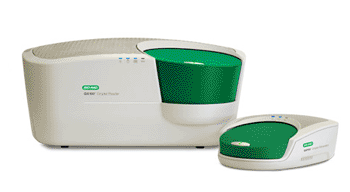First-Time Quantification of Tumor-Infiltrating T-Lymphocytes Paves Path to Cancer Survival Predictions
By LabMedica International staff writers
Posted on 18 Dec 2013
A new, droplet digital PCR (ddPCR) assay enables measurement of tumor-infiltrating T-lymphocytes (TILs) as a potential prognostic, cancer survival biomarker.Posted on 18 Dec 2013
The genomic DNA assay, named "QuanTILfy", was developed by a team led by Dr. Jason H. Bielas at the Fred Hutchinson Cancer Research Center (Seattle, WA, USA), using the “QX100” ddPCR system from Bio-Rad Laboratories (Hercules, CA, USA). QuanTILfy was then used to count TILs, determine their frequency, and develop a grouping system to classify clonality, which might be a marker of druggable targets. The paper reporting this first time TIL quantification system was published December 4, 2013, in the journal Science Translational Medicine.

Image: The QuanTILfy is performed using the QX100 ddPCR system (Photo courtesy of Bio-Rad Laboratories).
The assay was performed on primary tumors from 30 ovarian carcinoma patients with known survival outcomes, ranging from 1 to 122 months. TIL frequency was approximately 3-fold higher in patients with a survival rate of more than 5 years when compared with patients with survival rates of less than 2 years. Higher TIL levels correlated positively with patient survival, consistent with the hypothesis that TILs play an active role in suppressing tumor formation. The team also demonstrated that QuanTILfy could be used to accurately and reproducibly characterize T-cell clonality in patients with T-cell acute lymphoblastic leukemia. In each case, they saw a single QuanTILfy assay subgroup, indicative of clonal T-cell expansion. This finding was confirmed by deep sequencing.
While the presence and quantity of TILs strongly correlate with increased patient survival, current tests are semiquantitative at best and cannot be used for clinical decision-making. Because variability in the measurement and characterization of TILs has limited their clinical utility as biomarkers, the results of this study highlight the potential of a robust, standardizable DNA-based assay to assess TILs in a variety of cancer types.
The "genomic signature” of TILs (which exhibits a vast amount of diversity) determines the genetic identity, or clonality, of the T-cell receptors (TCR) expressed on each TIL. With the advent of digital PCR—and the generation of tens of thousands of data points produced by ddPCR—it is now possible to quantify these signatures, enabling the determination of the number of TILs. "There's no way you could do this with any method other than digital PCR because of the numerous primer pairs and probes that we have," said Dr. Bielas. ”Digital PCR partitions all the reactions so you can amplify these targets independently of PCR efficiency without any competing side reactions."
The QuanTILfy assay proved to be both sensitive and accurate. In a mixture of human T-cells purified from blood and normal human lung fibroblasts, the assay demonstrated the ability to detect a single TCR rearrangement among 10,000 tumor cells. It also demonstrated the ability of ddPCR technology to quantify a large number of markers simultaneously in a single reaction through multiplexing. Furthermore, this assay could also facilitate understanding of TIL quantification in relation to development of new immunotherapies for cancer. "Now that we have the sensitivity and ability to reproducibly count TILs in tumors, we may be able to stratify and more effectively treat patients based on tumor TIL count," said Dr. Bielas.
Related Links:
Fred Hutchinson Cancer Research Center
Bio-Rad Laboratories














